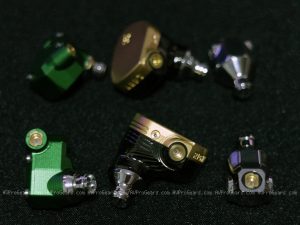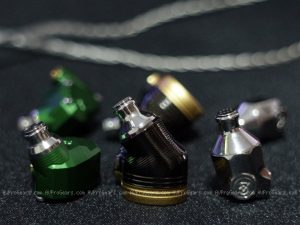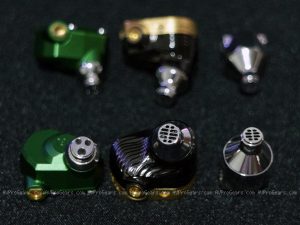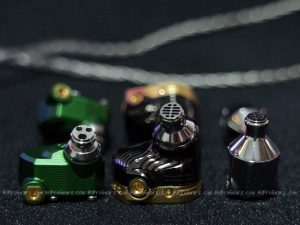Campfire Audio Solaris vs Atlas vs Andromeda Earphones: Review – Which One Is the Best For You?
The Campfire Audio Solaris is currently the flagship earphone that the company has to offer. It succeeded the Atlas, whose reign was somewhat short; and the Andromeda, the earphone that many audiophiles and audio enthusiasts enjoyed, even until today. I consider these three earphones, the Solaris, Atlas and Andromeda, the flagship lineup. They are the best earphones that the company has to offer. But these three earphones are quite different from one another. Each has its own unique design, they have different driver configurations, they fit differently, and they all sound different from one another. So which of the three earphone is the best one for you? Even though the Solaris is the flagship, it may not be the best for some. In this quick review, we are going to compare these three earphones.

Campfire Audio Solaris vs Atlas vs Andromeda – Features and Specifications
Let’s get straight to the point! The Campfire Audio Solaris features a hybrid design, meaning it uses a combination of balanced armature drivers and a dynamic driver in one shell. To be exact, the Solaris has two balanced armature drivers for the high frequency; a single ported balanced armature driver for the mid frequency; and a specially tuned 10mm dynamic driver for the mid and low frequencies. This gives the Solaris “the best of both worlds”; a clarity and precision of a balanced armature driver, and a bass performance that you can only get from a dynamic driver.
The Campfire Audio Atlas on the other hand, is using a single full range 10mm dynamic driver. Though it’s no ordinary dynamic driver, Campfire Audio is using an Amorphous Diamond Like Carbon diaphragm; making it possible for the Atlas to achieve superior fidelity, excellent frequency response, and low distortion. The Atlas is the direct successor of the Campfire Audio Vega, which also uses a dynamic driver but a smaller one, at 8mm.
The Campfire Audio Andromeda features an all balanced armature configuration. It has two balanced armature drivers for the high frequency; one balanced armature driver for the mid frequency; and two balanced armature drivers for the low frequency. As a result, the Andromeda produces a very detailed and crystal clear sounding music. While clarity and (micro) details is its forte, it is somehow weak when it comes to bass performance / presence. It’s quite difficult for a balanced armature driver to attain a bass performance similar to that of a dynamic driver.
All three earphones are physically and aesthetically different as well. The Solaris is physically the biggest among the three. It has a larger shell and the spout is a bit longer or larger as well. As a result, the Solaris tends to protrude on my ears and doesn’t sit well. That’s why finding the right ear tip and contouring the ear hooks properly helps in securing the position of the Solaris on my ears. The size (and fit) of the Solaris may be an issue, especially to those who has smaller ear concha.
The Atlas and Andromeda are easy to wear. They are not that big so the fit is not really an issue. The Atlas has the “traditional” earphone design, where you simply plug it on your ear. The cable doesn’t loop on top of your ear, it just dangles just like a typical earphone cable. I am not a fan of this design since there is a (big) chance that the Atlas gets pulled out from my ears easily when the cable gets caught or is pulled. This was my issue with earbuds and earphones many years ago. Ear tips are not a problem though since you get a plethora of options included in the package. I’m also not a fan of the super shiny stainless steel finish either. Don’t get me wrong, it looks great, it’s very shiny but it is also very prone to scratches. You have to take extra care to prevent it from getting scratches. Luckily, scratches doesn’t affect the sound in anyway, but if you’re going to spend $1,300 for an earphone, I’m sure you’d want it to look as good as possible and keep it that way.
The Andromeda on the other hand is the most comfortable to my ears. The design and cable is ear hook type and the spout is not that large or long. I can comfortably wear the Andromeda using either a set of silicon tip or foam tip. I prefer to wear the foam tips for precision and clarity; whereas the silicon tips gives the bass frequency a bit more presence.
I think it is a wise decision that Campfire Audio designed these three earphones differently. It’s like a collection of flagship earphones; telling you to “catch them all”! If I am going to rate their fit and comfort; I give the Andromeda the highest score, second the Atlas and finally the Solaris. As for looks, the Solaris definitely stands out!

Another important difference between the Solaris vs Atlas and Andromeda is their included or stock cables. The Andromeda comes with a Litz cable – a “good standard cable” featuring four silver plated copper conductors with individually enameled wires. The cable alone cost around $149 if purchased separately from Campfire Audio’s site. The Atlas comes with a better Pure Silver Litz cable. It is Campfire Audio’s pure silver premium standard cable featuring four pure silver litz wire with individually enameled wires. The Pure Silver Litz cable retails for $249 on CA’s site.
Finally, the flagship Solaris is paired with the Super Litz cable as its “stock cable”. The super litz cable is like a “supercharged” litz cable that is paired with the Andromeda. It features four silver plated copper conductors just like the Litz cable; but the strand count is doubled. That’s why you can see from the photo above the Super Litz cable is the thickest among the three cables. It cost $199 USD, not as expensive compared to the Pure Silver Litz that is paired with the Atlas, but it is no doubt a good cable as well.
| Campfire Audio | Solaris | Atlas | Andromeda |
|---|---|---|---|
| Driver Design | Hybrid (BA+DD) | Dynamic Driver | Balanced Armature Drivers |
| Driver Configuration | Dual Custom Balanced Armature Drivers (high) Single Custom Ported Balanced Armature Driver (mid) Specially Tuned 10mm Dynamic Driver (mid + low) | Full Range 10mm A.D.L.C. Diaphragm Dynamic Driver | Dual High Frequency Balanced Armature Drivers Single Mid Frequency Balanced Armature Driver Dual Low Frequency Balanced Armature Drivers |
| Additional Features | Tuned Acoustic Expansion Chamber Polarity Tuned Chamber 3D optimized acoustic construction Beryllium / Copper MMCX Connections Stainless Steel Spout | Plasma enhanced Chemical Vapor Depostion Amorphous Diamond Like Carbon (A.D.L.C.) Diaphragm Stainless Steel Body Beryllium / Copper MMCX Connections Stainless Steel Body | Tuned Acoustic Expansion Chamber Machined Aluminum Shell Beryllium / Copper MMCX Connections Stainless Steel Body |
| Frequency Response | 5Hz-20 kHz | 5Hz-20 kHz | 10Hz-28 kHz |
| Sensitivity | 115 dB SPL/mW | 105 dB SPL/mW | 112.8 dB SPL/mW |
| Impedance | 10 Ohms @ 1kHz | 19 Ohms @ 1kHz | 12.8 Ohms |
| Total Harmonic Distortion | Less than 1% | Less than 1% | |
| Included Cable | Campfire Audio Super Litz Cable | Campfire Audio Pure Silver Litz Cable | Campfire Audio Litz Cable |
| Price (USD) | $1,499 | $1,299 | $1,099 |
| Release Date | October 2018 | April 2018 | April 2016 |
UPDATE: Check latest pricing and availability at Campfire Audio’s store:
Sound Comparison – Solaris vs Atlas vs Andromeda Earphones

All the three earphones discussed here, the Solaris, Atlas and Andromeda, are very good earphones and impressive to say the least. But they do sound differently and each has their own unique tuning and sound characteristics. When it comes to the high frequency, the Solaris and Andromeda has better treble extension and detail compared to the Atlas. They are almost the same, but if you listen carefully, the Andromeda has the slight edge when it comes to the high frequency. To my ears, it has a bit more extension, or sparkle to it. But mind you the difference is very small. The Atlas has a good amount of treble extension as well, probably similar to that of the Solaris. But it sounds like the treble section is somewhat smooth on the Solaris compared to the Atlas’ peaking highs.
I guess when to come to the mid frequency, the Solaris has the better presentation. It sounds more natural and somewhat forward sounding compared to the Andromeda, just a bit as well. While the Andromeda sounds clean and clear, to my ears it lacks the texture and body that the Solaris and Atlas offer. However, when it comes to vocals, I like how they sound on the Solaris and Andromeda compared to the Atlas. Probably the Atlas is just a bit warm for my preference or the vocals are (a bit) laid back.
When it comes to bass performance, there is no doubt that the Atlas trumps on this. The bass goes deep and the rumble is more satisfying on the Atlas compared to what the Solaris has to offer. I think Campfire Audio toned down the bass performance or presence on the Solaris to balance the frequencies without overpowering one frequency to another. The transition from mids to lows is just smooth on the Solaris. The rumble is not that pronounced on the Solaris but the bass can go deep. Unfortunately for the Andromeda, it’s purely a BA-only earphone. So don’t expect to get dynamic driver-like bass performance with the Andromeda. There is still a good amount of bass on the Andromeda; it’s just that its impact is not as hard compared to the Atlas, neither its presence compared to the Solaris.
All three earphones have a good sound staging and layering. For me, the Andromeda has the best instrument separation, 3D imaging or sound staging compared to the Solaris and Atlas. The Solaris comes next and it’s close to what the Andromeda has to offer. The Atlas isn’t bad either as it sounds spacious and airy for a V-shaped earphone.
Closing Thoughts – Which Campfire Audio Flagship Earphone Is The Best For You?
At the end of the day, the Campfire Audio Solaris, Atlas and Andromeda are really good earphones. Each has its own unique strengths and weakness. The Solaris is overall the most balanced, although a bit smooth for my preference. You can throw any genre at it and it will still sound good. If you like sparkling highs, instrument separation, layering precision and clarity, the Andromeda would be your best choice. I like the Andromeda for classical music, strings, vocals and the likes. It’s also good for an all-around earphone. For bass lovers or for those who preferred a V-shape sound signature, the Atlas won’t disappoint you. Its bass is powerful and gives you satisfying rumbles and slam. I like the Atlas when I listen to EDMs, Lindsey Stirling, David Guetta and the likes.
If you have the money to spend, the three earphones would make for a really good collection. However if you can only choose one, the Solaris is a great all around earphone. The only thing you’ll have to worry is the fit. If you are still unsure at this point, I suggest you visit a local (audio) store and audition the three if possible. Campfire Audio also offers a 15-day no questions asked return policy if auditioning any of them is not possible in your location.












